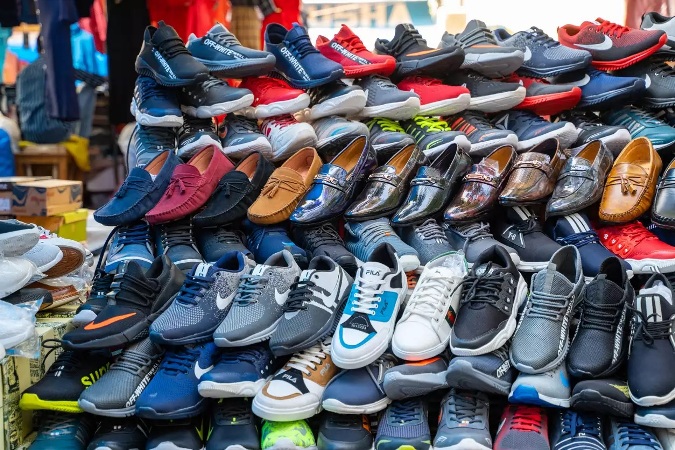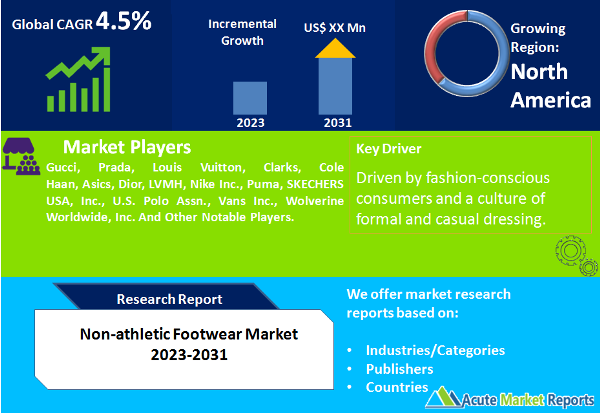
The non-athletic footwear market is expected to grow at a CAGR of 4.5% during the forecast period of 2025 to 2033. The market is a diverse sector within the global footwear industry, encompassing a wide range of footwear styles designed for everyday use, formal occasions, and fashion statements. The non-athletic footwear market is influenced by fashion and lifestyle trends, rising disposable income, and changing work attire norms. Despite economic uncertainties, the market continues to thrive, with lace-up and slip-on shoes being popular choices. Material preferences are shifting towards breathable options like mesh. Geographic trends favor Asia-Pacific, and top players in the market employ strategies centered on brand image and diversification to maintain their competitive edge.

Fashion and Lifestyle Trends
One of the primary drivers of the non-athletic footwear market is the ever-evolving fashion and lifestyle trends. As consumers seek to express their individuality and style, non-athletic footwear, including lace-up shoes and slip-on shoes, has become an integral part of their wardrobe. This trend is evidenced by the continuous demand for trendy and fashionable footwear options. The proliferation of fashion-conscious consumers and the growth of social media platforms that showcase diverse footwear styles. Consumers, influenced by celebrities and fashion influencers, are more inclined to invest in non-athletic footwear to keep up with the latest trends and make a fashion statement.
Increasing Disposable Income
Rising disposable income levels across the globe have had a significant impact on the non-athletic footwear market. As individuals and households enjoy higher incomes, they are more willing to spend on luxury and premium footwear options. This driver is further substantiated by the growth in demand for high-end and designer brands. The sales figures of luxury and premium footwear brands such as Gucci, Prada, and Louis Vuitton. These brands have reported substantial revenues in 2024, reflecting consumers' willingness to invest in non-athletic footwear that not only offers comfort but also conveys a sense of prestige and exclusivity.
The Casualization of Work Attire
The casualization of work attire is another key driver of the non-athletic footwear market. Many workplaces have shifted from strict formal dress codes to more relaxed and business-casual attire. As a result, there is a growing demand for non-athletic footwear that is both comfortable and appropriate for professional settings. The sales of formal yet comfortable footwear options such as leather lace-up shoes and stylish slip-ons. Professionals and office workers are increasingly opting for footwear that provides a balance between sophistication and comfort, aligning with the changing dynamics of modern workplaces.
Economic Uncertainty and Market Volatility
One notable restraint affecting the non-athletic footwear market is economic uncertainty and market volatility. Global economic fluctuations, trade tensions, and geopolitical events can have a significant impact on consumer confidence and spending patterns. Such uncertainty can lead consumers to reduce discretionary spending on non-essential items, including non-athletic footwear. Market demand for non-athletic footwear experienced fluctuations during periods of economic instability. Additionally, unexpected events, such as the COVID-19 pandemic, disrupted supply chains and hindered production and distribution, further exacerbating market volatility.
Market Segmentation by Product Type (Lace-Up Shoes, Slip-On Shoes): slip-on shoes to Present Significant Opportunities
The non-athletic footwear market is segmented by product type into various categories, with lace-up shoes and slip-on shoes being among the most prominent. In 2024, both categories contributed significantly to the market's revenue, reflecting their popularity among consumers seeking formal and casual footwear options. Looking ahead to the forecast period from 2025 to 2033, slip-on shoes are expected to exhibit the highest CAGR. This growth is attributed to their convenience and versatility, making them a preferred choice for individuals seeking comfortable yet stylish footwear options.
Market Segmentation by Material (Leather, Mesh, Natural Rubber, Polyester, Others): Leather-based Footwear Dominates in terms of Revenues
Material plays a crucial role in the non-athletic footwear market, influencing factors such as durability, comfort, and aesthetics. In 2024, leather-based footwear garnered significant revenue due to its premium and timeless appeal. However, the highest CAGR during the forecast period from 2025 to 2033 is projected for mesh-based footwear. Mesh materials are favored for their breathability and lightweight properties, making them ideal for casual and everyday wear. The growing preference for comfortable and breathable footwear aligns with the expected increase in demand for mesh-based non-athletic shoes.
North America Remains as the Global Leader
The non-athletic footwear market exhibits varying geographic trends, with different regions experiencing distinct levels of demand and growth. North America and Europe have traditionally been strong markets for non-athletic footwear, driven by fashion-conscious consumers and a culture of formal and casual dressing. In 2024, North America led in terms of revenue share. However, the Asia-Pacific region is expected to witness the highest CAGR during the forecast period from 2025 to 2033. Rising disposable incomes, urbanization, and a growing middle class in countries like China and India are fueling demand for non-athletic footwear. This region is also becoming a hub for luxury and premium brands, further boosting market growth. Additionally, Latin America and the Middle East & Africa regions are expected to experience moderate growth, albeit from smaller market bases.
Market Competition to Intensify during the Forecast Period
The non-athletic footwear market is highly competitive, with numerous players competing for market share. In 2024, top players such as Gucci, Prada, Louis Vuitton, Clarks, Cole Haan, Asics, Dior, LVMH, Nike Inc., Puma, SKECHERS USA, Inc., U.S. Polo Assn., Vans Inc., and Wolverine Worldwide, Inc. were prominent in the market, collectively contributing significantly to industry revenues. These leading companies have adopted various strategies to maintain their competitiveness. They have focused on brand image, product diversification, and marketing campaigns to attract consumers seeking luxury and premium non-athletic footwear. Collaborations with celebrities and fashion influencers have also been instrumental in driving brand recognition and sales. As expected, these players are anticipated to continue their strategies in the forecast period from 2025 to 2033. However, the market may also see the emergence of niche and sustainable footwear brands catering to environmentally conscious consumers.
Historical & Forecast Period
This study report represents analysis of each segment from 2023 to 2033 considering 2024 as the base year. Compounded Annual Growth Rate (CAGR) for each of the respective segments estimated for the forecast period of 2025 to 2033.
The current report comprises of quantitative market estimations for each micro market for every geographical region and qualitative market analysis such as micro and macro environment analysis, market trends, competitive intelligence, segment analysis, porters five force model, top winning strategies, top investment markets, emerging trends and technological analysis, case studies, strategic conclusions and recommendations and other key market insights.
Research Methodology
The complete research study was conducted in three phases, namely: secondary research, primary research, and expert panel review. key data point that enables the estimation of Non-athletic Footwear market are as follows:
Market forecast was performed through proprietary software that analyzes various qualitative and quantitative factors. Growth rate and CAGR were estimated through intensive secondary and primary research. Data triangulation across various data points provides accuracy across various analyzed market segments in the report. Application of both top down and bottom-up approach for validation of market estimation assures logical, methodical and mathematical consistency of the quantitative data.
| ATTRIBUTE | DETAILS |
|---|---|
| Research Period | 2023-2033 |
| Base Year | 2024 |
| Forecast Period | 2025-2033 |
| Historical Year | 2023 |
| Unit | USD Million |
| Segmentation | |
Product
| |
Material
| |
End-User
| |
Price
| |
Distribution Channel
| |
|
Region Segment (2023-2033; US$ Million)
|
Key questions answered in this report